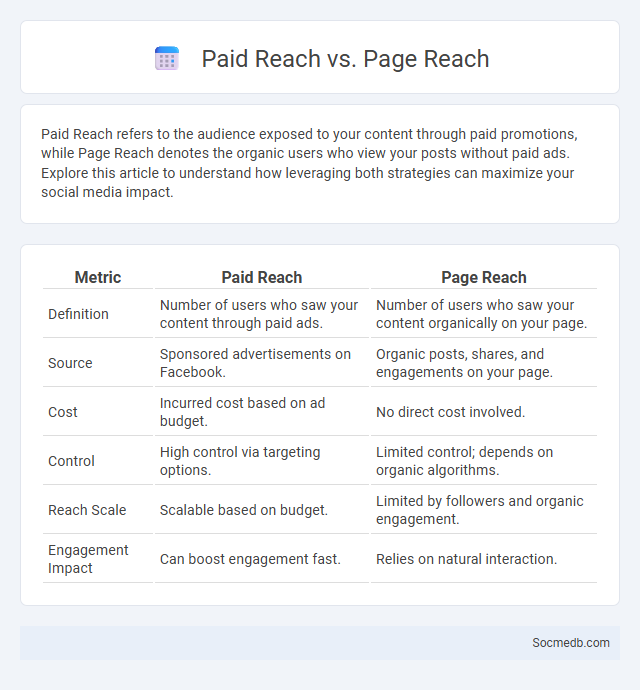
Photo illustration: Paid Reach vs Page Reach
Paid Reach refers to the audience exposed to your content through paid promotions, while Page Reach denotes the organic users who view your posts without paid ads. Explore this article to understand how leveraging both strategies can maximize your social media impact.
Table of Comparison
| Metric | Paid Reach | Page Reach |
|---|---|---|
| Definition | Number of users who saw your content through paid ads. | Number of users who saw your content organically on your page. |
| Source | Sponsored advertisements on Facebook. | Organic posts, shares, and engagements on your page. |
| Cost | Incurred cost based on ad budget. | No direct cost involved. |
| Control | High control via targeting options. | Limited control; depends on organic algorithms. |
| Reach Scale | Scalable based on budget. | Limited by followers and organic engagement. |
| Engagement Impact | Can boost engagement fast. | Relies on natural interaction. |
Introduction to Social Media Reach Metrics
Social media reach metrics measure the total number of unique users exposed to your content, providing insight into how far your message has spread across platforms. These metrics include impressions, reach, and engagement rates, which help you understand your audience size and content visibility. Monitoring reach metrics allows you to optimize marketing strategies and enhance your brand's online presence effectively.
Defining Paid Reach
Paid reach on social media refers to the total number of unique users who see content as a result of paid promotions, such as advertisements and sponsored posts. It directly impacts brand visibility by targeting specific demographics through platforms like Facebook Ads, Instagram Sponsored Stories, and Twitter Promoted Tweets. Measuring paid reach helps marketers evaluate the effectiveness of their advertising spend and optimize campaigns for maximum engagement and conversion rates.
Understanding Page Reach
Page reach on social media measures the total number of unique users who have seen your content, providing critical insights into your audience size and engagement potential. Understanding reach helps optimize your posting strategy by identifying which content resonates most and the best times to share for maximum visibility. Tracking and analyzing reach metrics enables you to refine targeting efforts, increase brand awareness, and grow your online presence effectively.
Key Differences: Paid Reach vs Page Reach
Paid reach on social media refers to the number of users who see your content through paid advertisements or promoted posts, often targeting specific demographics to maximize exposure. Page reach measures the organic visibility of your content, reflecting how many unique users encounter posts through natural interactions like shares, comments, and likes. Understanding the distinction helps you strategically allocate your marketing budget to enhance Your brand's visibility and engagement effectively.
Importance of Paid Reach in Social Media Marketing
Paid reach in social media marketing significantly amplifies Your brand's visibility by targeting specific demographics and increasing engagement rates. Leveraging paid advertising options on platforms like Facebook, Instagram, and LinkedIn ensures Your content reaches beyond organic followers, driving higher conversion rates and measurable ROI. Investing in paid reach allows precise audience segmentation, maximizing the effectiveness of Your marketing campaigns and fostering sustained growth.
How Organic Page Reach Impacts Engagement
Organic page reach directly influences social media engagement by determining how many users see and interact with content without paid promotion. Higher organic reach increases visibility, leading to more likes, comments, shares, and overall user interaction. Optimizing content for relevance and timing enhances organic reach, driving sustained engagement and fostering community growth on platforms like Facebook and Instagram.
Measuring the Effectiveness of Paid Reach
Measuring the effectiveness of paid reach on social media involves tracking key performance indicators such as engagement rates, click-through rates (CTR), and conversion rates to assess how well paid campaigns resonate with target audiences. Utilizing analytics tools like Facebook Ads Manager, Google Analytics, and LinkedIn Campaign Manager helps quantify return on investment (ROI) by correlating paid impressions with actual user actions. Accurate attribution models and A/B testing further refine campaign strategies by identifying which paid content drives the most meaningful interactions and business outcomes.
Strategies to Maximize Both Paid and Page Reach
Social media strategies to maximize both paid and page reach involve precise audience targeting, leveraging lookalike audiences, and using engaging content tailored to platform algorithms. You should analyze performance metrics regularly to optimize ad spend and organic posts, ensuring a balanced mix of promotional and authentic engagement. Integrating retargeting campaigns and timing posts based on peak user activity significantly enhances visibility and interaction on your page.
Common Mistakes in Interpreting Reach Data
Interpreting social media reach data often leads to overestimating audience engagement by confusing reach with impressions, as reach counts unique viewers while impressions include multiple views by the same user. Many marketers overlook the impact of algorithm changes that affect organic reach, resulting in misaligned expectations and strategy outcomes. Reliance on reach metrics alone ignores qualitative factors like audience relevance and sentiment, which are crucial for a comprehensive evaluation of social media campaign effectiveness.
Choosing the Right Reach Strategy for Your Goals
Selecting the right reach strategy on social media involves analyzing your target audience, campaign objectives, and budget to maximize engagement and conversion. You should prioritize platforms and content formats that align with your brand values and resonate with user behavior patterns. Understanding metrics such as impressions, reach frequency, and click-through rates helps refine your approach for optimal results.
 socmedb.com
socmedb.com